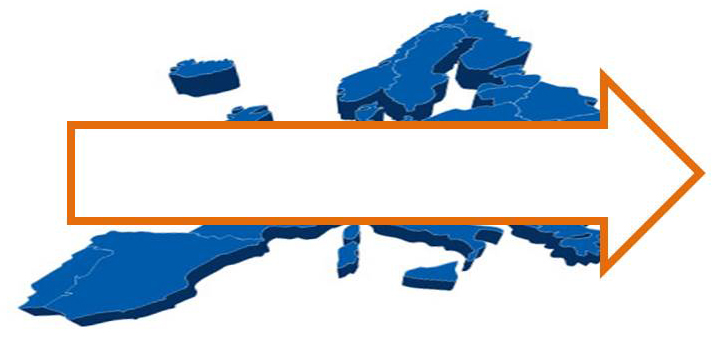The TopoEurope Meeting is financially supported by the European Space Agency, the Academia Europea, the European Science Foundation, the International Lithosphere Program, the Côte d’Azur Observatory and Geoazur.
The TOWN OF ANTIBES has put the Espaces de Fort Carré at our disposal at no charge. The local training hub "Vert d'Azur" in Antibes provides the decoration of the conference space.
 THE EUROPEAN SPACE AGENCY :
THE EUROPEAN SPACE AGENCY :
The European Space Agency (ESA) is Europe’s gateway to space. ESA is an intergovernmental organisation, created in 1975, with the mission to shape the development of Europe’s space capability and ensure that investment in space delivers benefits to the citizens of Europe and the world.
ESA will soon have 22 Member States: Austria, Belgium, the Czech Republic, Denmark,Estonia, Finland, France, Germany, Greece, Hungary, Ireland, Italy,Luxembourg, the Netherlands, Norway, Poland, Portugal, Romania, Spain, Sweden, Switzerland and the United Kingdom, of whom 18 are Member States of the EU.
ESA has Cooperation Agreements with eight other Member States of the EU and is discussing an Agreement with the one remaining (Bulgaria). Canada takes part in some ESA programmes under a Cooperation Agreement.
By coordinating the financial and intellectual resources of its members, ESA can undertake programmes and activities far beyond the scope of any single European country. ESA develops the launchers, spacecraft and ground facilities needed to keep Europe at the forefront of global space activities. Today, it launches satellites for Earth observation, navigation, telecommunications and astronomy, sends probes to the far reaches of the Solar System and cooperates in the human exploration of space.
 THE ACADEMY OF EUROPE
THE ACADEMY OF EUROPE
Academia Europaea is an European, non-governmental association acting as an Academy. Our members are scientists and scholars who collectively aim to promote learning, education and research. Founded in 1988, with about 3000 members which includes leading experts from the physical sciences and technology, biological sciences and medicine, mathematics, the letters and humanities, social and cognitive sciences, economics and the law.
 THE EUROPEAN SCIENCE FOUNDATION
THE EUROPEAN SCIENCE FOUNDATION
With 40 years’ experience in all areas of research, the European Science Foundation (ESF) was originally set up to act as a coordinating body for Europe’s main research funding and research performing organisations. But as the research landscape has evolved, so has ESF’s role in supporting scientific endeavours.
Today ESF is continuing to honour its commitments to its Member Organisations and the science community through the coordination of collaborative research programmes in all scientific domains, but we are winding down these traditional research activities to reach completion by the end of 2015. Our current role, in today’s changing climate, needs to be redefined. Europe has overcome past obstacles, but is facing new challenges; at ESF we have the experience and agility to develop solutions and services to face these new challenges and turn them into opportunities.
 THE INTERNATIONAL LITHOSPHERE PROGRAM
THE INTERNATIONAL LITHOSPHERE PROGRAM
The International Lithosphere Program (ILP) seeks to elucidate the nature, dynamics, origin and evolution of the lithosphere through international, multidisciplinary geoscience research projects and coordinating committees. The ILP is charged with promoting multidisciplinary research projects of interest to both the geological (International Union of Geological Sciences, IUGS) and geophysical (IUGG) communities.
The ILP seeks to achieve a fine balance between: "addressing societal needs", e.g. understanding natural catastrophes and other solid earth processes that affect the biosphere, providing information for improved resource exploration and environmental protection; and "satisfying scientific curiosity". The ILP was established in 1980 by the International Council for Science (ICSU) at the request of the and the IUGG and IUGS. Since 2006 ILP is a joint Program of the Unions.
 THE COTE D'AZUR OBSERVATORY
THE COTE D'AZUR OBSERVATORY
The Côte d’Azur Observatory has a remarkable architectural and scientific heritage, which is open to the public. But far from looking to the past, OCA remains an internationally recognized center for research in Earth Sciences and Astronomy. Today, the buildings designed by Charles Garnier consort with precision mechanics, high performance computing centers and virtual observatories.
With some 450 staff located on four sites (Mont Gros and Valrose in Nice, Sophia Antipolis, and the Plateau de Calern observatory), OCA is one of 25 French astronomical observatories responsible for the continuous and systematic collection of observational data on the Earth and the Universe. Its role is to explore, understand and transfer knowledge about Earth sciences and astronomy, whether in astrophysics, geosciences, or related sciences such as mechanics, signal processing, or optics.
 HUB OF TRAINING "VERT D'AZUR"
HUB OF TRAINING "VERT D'AZUR"
The layout of « Espaces du Fort Carré » is realized by the students of CFPPA for a training of the « Evert’mentiel » course
We are located in Antibes.. Our site of 10 hectares include 4 centers :
- A high school (known as « le pôle de formation Vert d’Azur ») : general education, technological trainings, scientific trainings and vocational trainings.
- A learning center : apprenticeship (CFPPA)
- A continuing education center : adult trainees (CFPPA)
- A horticultural domain : site of study, research, innovation and development.
Our trainings begin in the last year of middle school (in french : classe de troisième) until the Class of Engineers.
Our fields of expertise are : landscaping, environment, horticulture, water management, riding, general education, technological and scientific trainings.
Our hub of training counts about 1500 learners.

